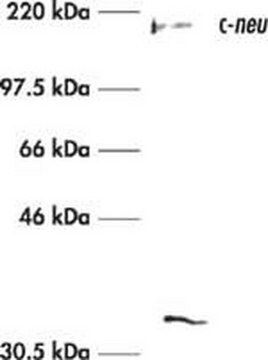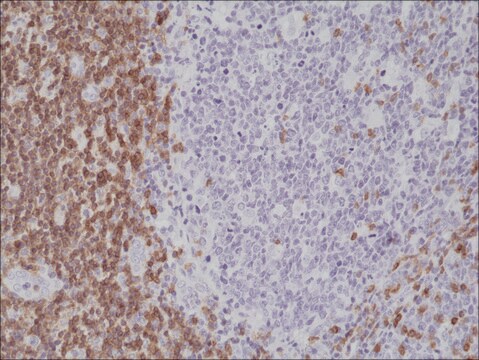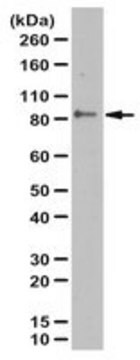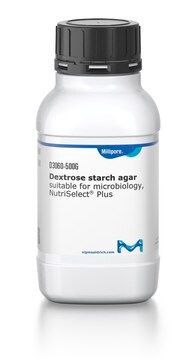ABE1859
Anti-KAP-1/TRIM28 Antibody
serum, from rabbit
Synonim(y):
Transcription intermediary factor 1-beta, TIF1-beta, E3 SUMO-protein ligase TRIM28, KRAB-associated protein 1, KAP-1, KRAB-interacting protein 1, KRIP-1, Nuclear corepressor KAP-1, RING finger protein 96, Tripartite motif-containing protein 28, KAP-1/TRI
About This Item
Polecane produkty
pochodzenie biologiczne
rabbit
Poziom jakości
forma przeciwciała
serum
rodzaj przeciwciała
primary antibodies
klon
polyclonal
reaktywność gatunkowa
mouse, human
metody
immunocytochemistry: suitable
immunoprecipitation (IP): suitable
western blot: suitable
numer dostępu NCBI
numer dostępu UniProt
Warunki transportu
dry ice
docelowa modyfikacja potranslacyjna
unmodified
informacje o genach
mouse ... Trim28(21849)
Opis ogólny
Kruppel-associated box-/KRAB-associated protein 1 (KAP-1) is a transcriptional co-repressor that selectively targets the KRAB domain of zinc finger protein-based transcription factors with its N-terminal tripartite RBCC (RING, b-box, coiled-coil) domain. KAP-1 uses its C-terminal PxVxL motif and the PHD-Bromo domain to recruit chromatin modifiers, such as heterochromatin protein 1 (HP-1), Histone-lysine N-methyltransferase SETDB1, nucleosome remodeling and deacetylation (NuRD) complex, and histone deacetylases (HDACs), for transcriptional repression. KAP-1 also plays an essential role in the DNA damage response (DDR). Upon DNA damage, KAP-1 is rapidly phosphorylated by Ataxia telangiectasia mutated (ATM) on Ser824, causing chromatin relaxation to facilitate DNA repair. In addition, SIRT1-mediated KAP-1 deacetylation is reported to stabilize KAP1 and 53BP1 interaction, resulting in an enhancement of NHEJ-mediated repair efficiency in a KAP-1 pSer824-independent manner.
Specyficzność
Immunogen
Zastosowanie
Epigenetics & Nuclear Function
Nuclear Receptors
Western Blotting Analysis: A representative lot detected similar level of endogenous KAP-1/Trim28 in HEK293T cells regardless of ionizing radiation treatment or shRNA-mediated SirT1 downregulation (Lin, Y.H., et al. (2015). PLoS One. 10(4):e0123935).
Western Blotting Analysis: A representative lot detected KAP-1/Trim28 in whole cell lysates, but not in BAP1, FoxK1, or FoxK2 immunoprecipitate (Okino, Y., et al. (2015). J. Biol. Chem. 16;290(3):1580-1591).
Immunoprecipitation Analysis: 10 µL from a representative lot immunoprecipitated KAP-1/Trim28 from HEK293T cell lysates (Courtesy of Dr. Zhenkun Lou, Mayo clinic, Rochester, MN).
Immunocytochemistry Analysis: An 1:1000 dilution from a representative lot detected KAP-1/Trim28 nuclear localization in U2OS cells (Courtesy of Dr. Zhenkun Lou, Mayo clinic, Rochester, MN).
Immunoprecipitation Analysis: A representative lot co-immunoprecipitated SirT1 with KAP-1/Trim28 from HEK293T cell lysates (Lin, Y.H., et al. (2015). PLoS One. 10(4):e0123935).
Western Blotting Analysis: An 1:1000 dilution from a representative lot detected KAP-1/Trim28 in mouse embryonic fibroblast (MEF) lysate, as well as downregulated KAP-1/Trim28 in lysates from KAP1 siRNA-treated HEK293T cells (Courtesy of Dr. Zhenkun Lou, Mayo clinic, Rochester, MN).
Jakość
Western Blotting Analysis: A 1:2,000 dilution of this antibody detected KAP-1/TRIM28 in 10 µg of HEK293T cell lysate.
Opis wartości docelowych
Postać fizyczna
Przechowywanie i stabilność
Handling Recommendations: Upon receipt and prior to removing the cap, centrifuge the vial and gently mix the solution. Aliquot into microcentrifuge tubes and store at -20°C. Avoid repeated freeze/thaw cycles, which may damage IgG and affect product performance.
Inne uwagi
Oświadczenie o zrzeczeniu się odpowiedzialności
Nie możesz znaleźć właściwego produktu?
Wypróbuj nasz Narzędzie selektora produktów.
Kod klasy składowania
12 - Non Combustible Liquids
Klasa zagrożenia wodnego (WGK)
WGK 1
Temperatura zapłonu (°F)
Not applicable
Temperatura zapłonu (°C)
Not applicable
Certyfikaty analizy (CoA)
Poszukaj Certyfikaty analizy (CoA), wpisując numer partii/serii produktów. Numery serii i partii można znaleźć na etykiecie produktu po słowach „seria” lub „partia”.
Masz już ten produkt?
Dokumenty związane z niedawno zakupionymi produktami zostały zamieszczone w Bibliotece dokumentów.
Nasz zespół naukowców ma doświadczenie we wszystkich obszarach badań, w tym w naukach przyrodniczych, materiałoznawstwie, syntezie chemicznej, chromatografii, analityce i wielu innych dziedzinach.
Skontaktuj się z zespołem ds. pomocy technicznej








